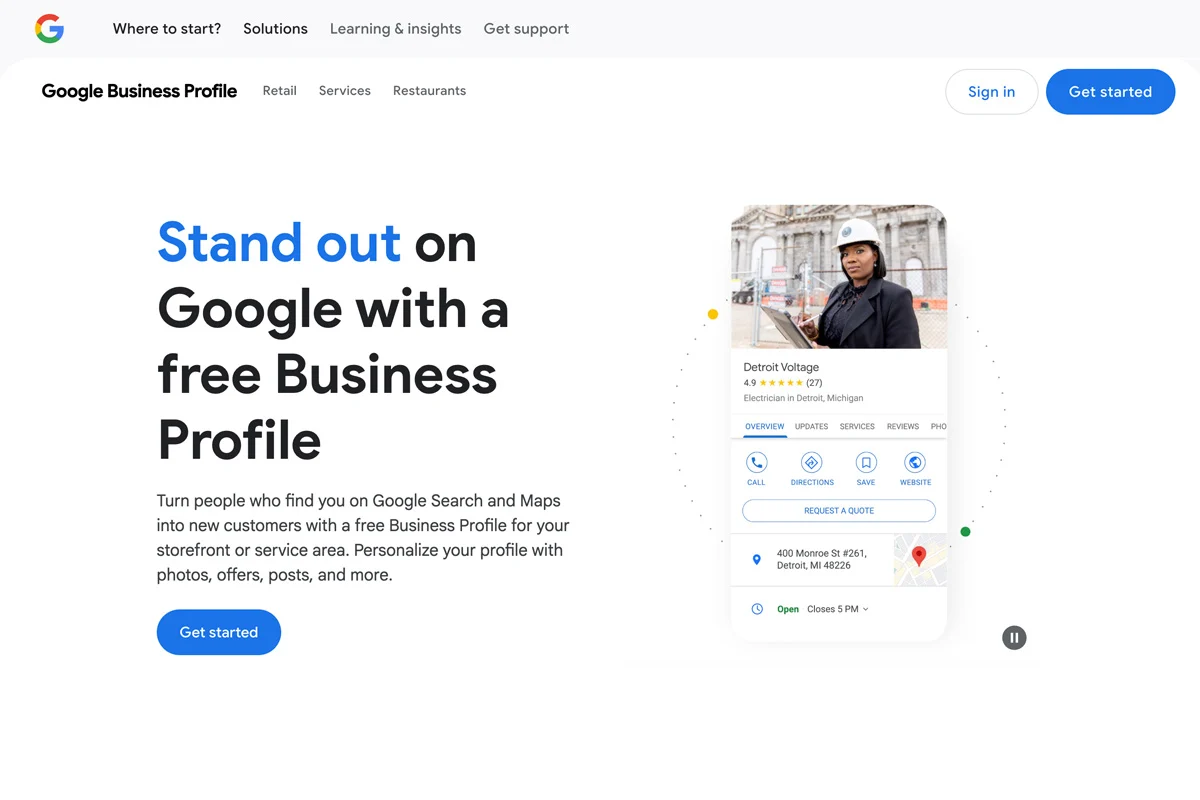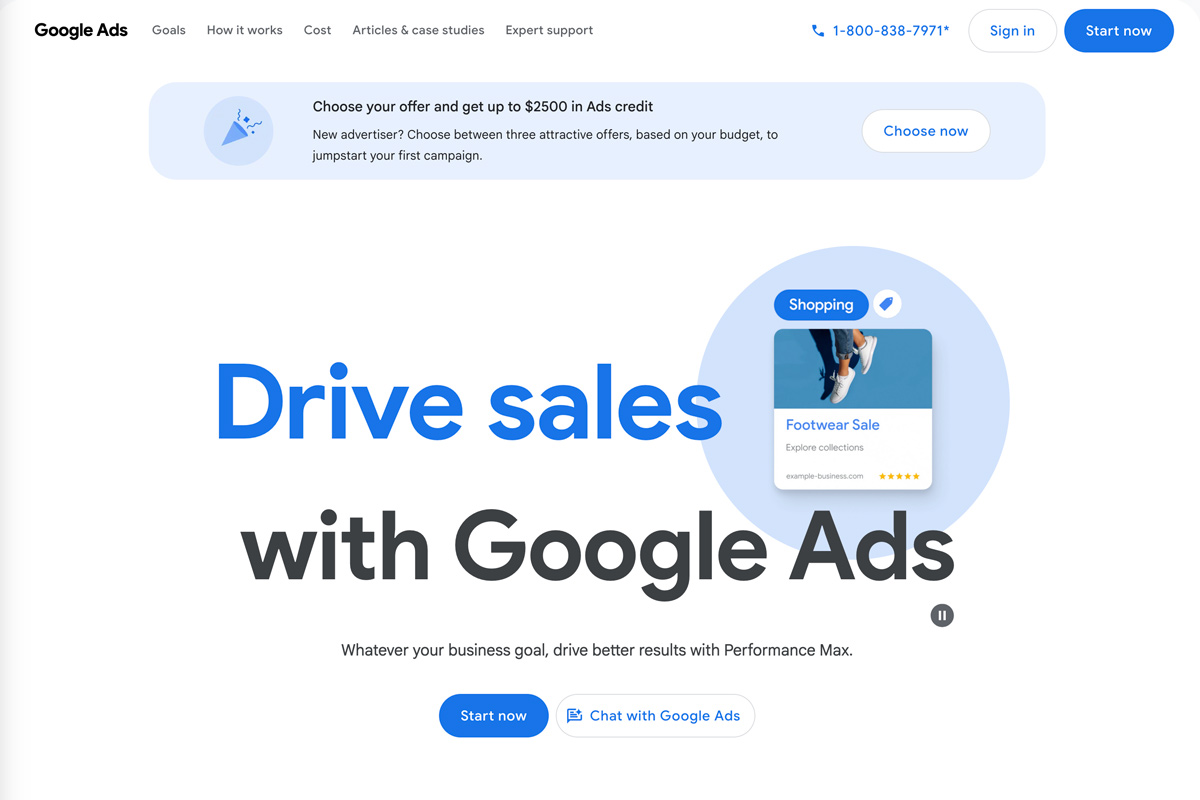What Is Daycare SEO and Why It Matters
When parents start looking for child care, they turn to search engines first. A quick search for "daycare near me" or "affordable child care in [your city]" brings up a list of local providers—and if your center doesn’t show up near the top, you’re already out of the running. That’s where daycare SEO comes in.
SEO is the process of making your website and overall online presence more visible in search engines like Google. It includes everything from optimizing your Google Business Profile to updating your website with keywords that match what parents are actually searching for. Done right, SEO helps your center appear in the moments when families are actively making child care decisions.
It’s not just about traffic. Good SEO brings the right traffic—local parents who are looking for the exact services you offer. Whether it’s full-time daycare, part-time preschool, or flexible hours for working parents, SEO makes sure your offerings are visible at the right time, to the right people.
Why Daycare Centers Can’t Afford to Ignore SEO
Parents today aren’t flipping through phone books or relying solely on referrals—they’re searching online. And their expectations are high. If your daycare doesn’t have a strong presence when someone searches locally, it’s likely that your competitors will capture that lead instead.
Ranking higher in search results leads directly to more calls, more tours, and more enrollments. Most parents won’t scroll past the first page of search results, so if your website isn’t optimized, you’re missing out on families who are ready to make a decision.
But it’s not just about ranking—it’s also about credibility. When a parent sees a daycare center with a polished website, glowing reviews, and a complete Google listing, it sends a strong message of professionalism and trustworthiness. These elements make a lasting impression before they even make a call or schedule a visit.
SEO also works for you over the long term. Unlike paid ads, which disappear the moment your budget runs out, the results of strong SEO continue to drive visibility long after the work is done. It’s one of the few marketing strategies where the investment compounds over time.
Lastly, SEO gives you a competitive edge. Parents don’t just call the first daycare they see—they compare options. A well-optimized online presence makes your center stand out and builds confidence from the very first click.

Standing Out in a Crowded Childcare Market
The daycare industry is competitive, especially in growing cities and suburban neighborhoods. Even if you offer a fantastic program with a great team and a welcoming space, none of that matters if parents can’t find you online. That’s why SEO is no longer optional—it’s foundational.
Most local markets have dozens of providers competing for the same group of parents. Some centers lean heavily on word-of-mouth, which still matters, but it’s no longer enough. Parents often get a recommendation and still Google the center before taking action. That’s your first impression—and it needs to count.
The good news? Many daycare centers still haven’t fully embraced digital marketing, which means there's room to rise above the noise. SEO allows you to outpace the competition by focusing on the platforms and channels parents already use to find care. If you invest in optimizing your visibility online—particularly through Google—you’re putting yourself in front of families before they even start calling around.
Strong SEO efforts focus on a few key areas: your Google Business Profile, your website content, your presence in local directories, and your online reviews. When these pieces work together, they create a consistent and persuasive digital footprint that gives you an edge—even in saturated markets.
How Parents Search for Childcare Online
Understanding how parents actually search for daycare services is one of the most overlooked elements of SEO. It's not just about picking some keywords—it’s about aligning your content with the intent behind those searches.
Most parents start with a very specific need. They’ll type something like “infant daycare near me,” “preschool with extended hours,” or “daycare with cameras for parents.” These aren’t random queries—they’re driven by pain points, schedules, trust concerns, and location preferences.
In general, parent searches fall into three categories:
- Informational: They’re looking for help or answers. Example: “What’s the best age to start daycare?”
- Navigational: They’re trying to find a specific provider. Example: “Little Explorers Preschool website.”
- Transactional: They’re ready to act. Example: “affordable daycare open now near me.”
This breakdown matters because your content strategy should address all three. Your service pages and Google profile should cater to transactional searches, while your blog and FAQs help with informational ones. Navigational searches, on the other hand, rely on brand recognition—making your name more memorable through consistent branding and social proof.
Parents also use multiple platforms during their decision-making process. Google is still the starting point, but platforms like Facebook, Yelp, and Care.com play supporting roles. Many will scroll through local parenting forums or ask in neighborhood Facebook groups for recommendations—only to circle back and Google the names that come up.
This cycle means your online presence needs to be aligned across every touch point: your listings, your website, your social media, and your reviews. When parents see consistent branding, clear information, and up-to-date details everywhere they look, it reduces friction and builds trust.
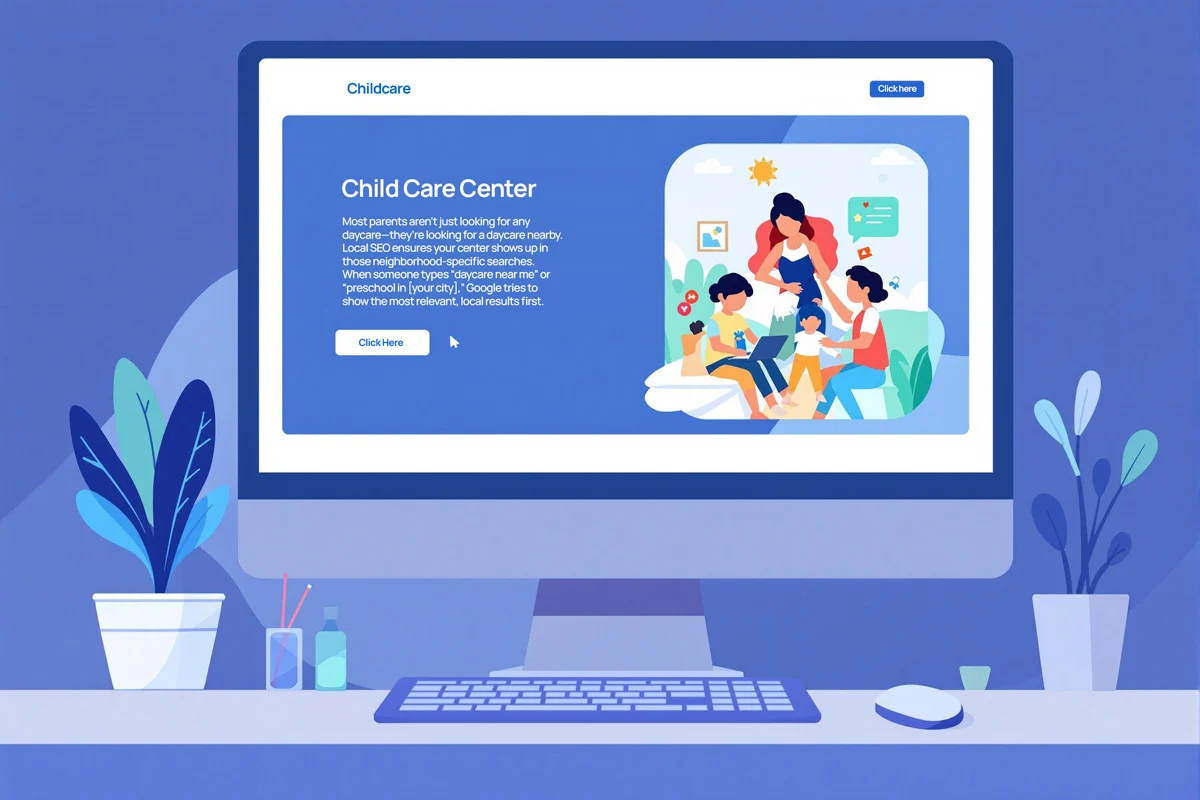
Why Local SEO Is the Backbone of Daycare Marketing
Most parents aren’t just looking for any daycare—they’re looking for a daycare nearby. Local SEO ensures your center shows up in those neighborhood-specific searches. When someone types “daycare near me” or “preschool in [your city],” Google tries to show the most relevant, local results first. That means location data, proximity, and local authority matter more than ever.
Showing up in the local map results (what’s called the Google “Local Pack”) gives your center a front-row seat in search results. It’s especially important for mobile users, who are often ready to act quickly—calling, scheduling a tour, or getting directions right from their phones.
Local SEO also increases in-person visits. Parents are more likely to visit a center they’ve already seen online, especially if it appears trusted, well-reviewed, and active. Even if you don’t have a huge marketing budget, a strong local presence levels the playing field—and gives you a much better shot at connecting with families who are nearby and ready to enroll.
See how Complete SEO helped a local South Austin daycare stand out by improving visibility for local families.
Setting Up and Optimizing Your Google Business Profile
Your Google Business Profile (formerly Google My Business) is one of the most important tools for local visibility—and yet, it’s often overlooked or only half-complete. A fully optimized profile makes your daycare more visible in Google Search and Google Maps, while also giving parents the info they need at a glance.
If a parent searches your name or finds you through a “near me” query, your profile might be the very first thing they see. It should look polished and complete.
Here’s how to optimize your Google Business Profile for daycare:
- Use your official daycare name, exactly as it appears on signage and your website.
- Make sure your address, phone number, and website URL are accurate and match what’s listed elsewhere online.
- List all relevant services and amenities—such as infant care, preschool programs, after-school options, early learning curriculum, or bilingual instruction.
- Upload high-quality images of your classrooms, play areas, outdoor space, and staff. Parents want to see where their children might spend their day.
- Set and regularly update your hours of operation, including any holiday closures.
- Enable messaging so parents can contact you directly through your listing.
- Use the “From the Business” section to write a short, keyword-rich description of your center, programs, and values.
Google rewards engagement, so don’t just set it and forget it. Respond to reviews, answer questions, and keep your photos fresh to show Google—and potential families—that you’re active and responsive.
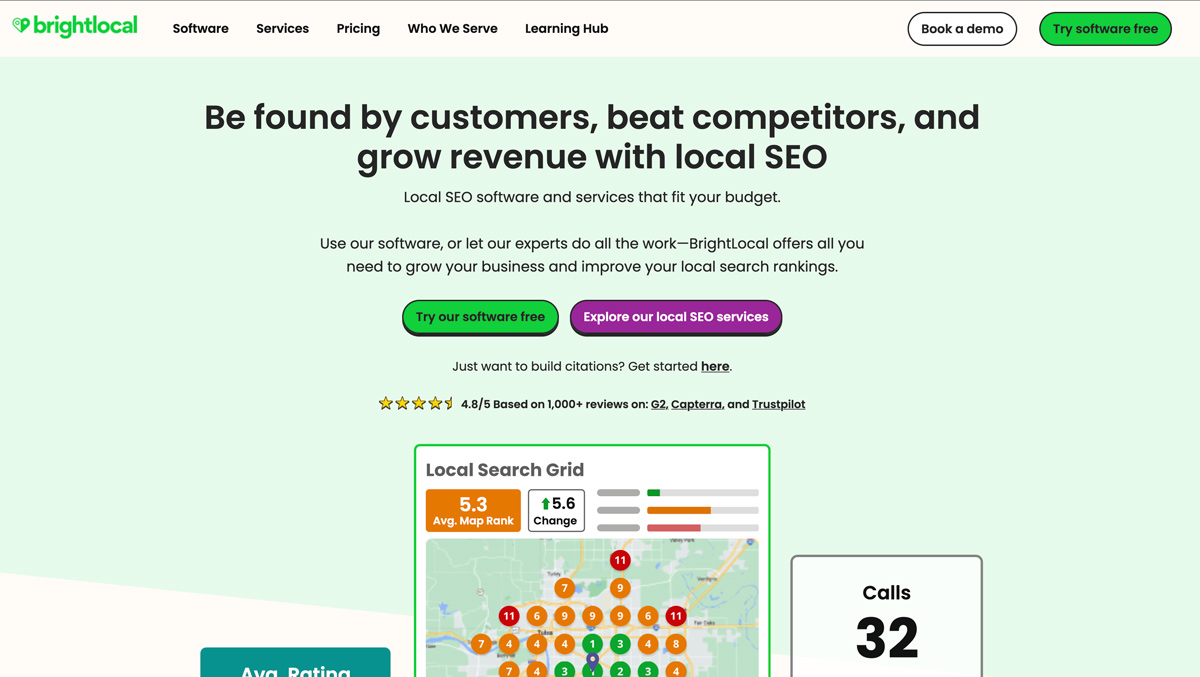
The Role of NAP Consistency in Local Rankings
One of the simplest but most critical elements of local SEO is keeping your NAP—Name, Address, and Phone Number—consistent across the web. Inconsistent information can confuse both parents and search engines, leading to lower rankings or even duplicate listings.
Here’s how to ensure your NAP is consistent:
- Start with your website footer. This is often the source other listings pull from.
- Check your details on major platforms like Google, Facebook, Yelp, Care.com, BBB, and any local directories.
- Use a tool like Moz Local or BrightLocal to scan the web for inconsistencies.
- If you move locations or change phone numbers, update your NAP everywhere—immediately. Leaving outdated listings live will hurt your rankings and confuse parents.
- Avoid using different formats (e.g., “St.” vs. “Street,” or using a tracking phone number only on directories). Keep it uniform.
Think of NAP as your digital business card. If it’s inconsistent, Google may not trust your listing—and neither will parents.
Getting Listed in Local and Childcare Directories
Directories are more than just digital Yellow Pages—they’re a way to build trust, earn backlinks, and improve visibility in both search engines and community circles. And for daycare centers, being listed in the right places can lead to direct inquiries and better local SEO.
Here’s where you should aim to be listed:
- Google Business Profile
- Yelp
- Care.com
- Facebook Business Pages
- Better Business Bureau (BBB)
- Angi (formerly Angie’s List)
- Local parenting sites and forums
- Chamber of Commerce or city business directories
When adding your daycare to these platforms, make sure to:
- Use consistent NAP details
- Choose the correct business category (e.g., Childcare, Preschool, etc.)
- Write a short but compelling description with a few keywords naturally included
- Add photos where possible
- Include links to your website and social media profiles
Even if each listing only sends a few visitors, the combined effect builds authority—and helps search engines recognize your daycare as an established, trusted local provider.
Earning and Showcasing Positive Reviews
Online reviews are one of the most powerful ranking factors for local SEO. But more importantly, they’re a major influence on parents making decisions about who to trust with their child’s care.
Search engines view reviews as a trust signal. The more high-quality, recent reviews your daycare receives—especially on Google—the more favorably Google will rank your listing. But it’s not just about volume. Reviews that mention your services, staff, or facilities in detail help your listing stand out and influence parents who are comparing multiple options.
Here’s how to actively build a review strategy:
- Ask happy parents to leave a review after a positive experience, such as a smooth transition into a new program or after a successful parent-teacher meeting.
- Send follow-up emails thanking them for enrolling and including a direct link to your Google review page.
- Include a review prompt on your website or in your newsletters. Make it easy, specific, and optional—but don’t be afraid to ask.
- Respond to every review—positive or negative. Thank reviewers for their feedback, and show empathy and professionalism when addressing concerns.
- Share the love—highlight great reviews on your website and social media to build additional trust.
Some daycare owners hesitate to ask for reviews, but most parents are happy to share their experience if asked. It’s one of the most impactful, low-cost ways to improve both your SEO and your reputation.
Keyword Research for Daycare SEO
To rank well in search results, you need to understand what parents are actually searching for—and why. Keyword research helps you uncover the exact phrases families use when looking for child care, preschool programs, or early education support. But it's not just about volume—it's about matching your content to real intent.
Parents searching for daycare typically fall into one of three intent categories:
- Informational: They're gathering knowledge. Example: “how to transition a toddler into daycare”
- Navigational: They're looking for a specific provider. Example: “Little Cubs Learning Center hours”
- Transactional: They're ready to take action. Example: “best bilingual preschool near me”
You want your website to rank for all three types of queries. That means your homepage and service pages should target high-intent transactional searches, while your blog and FAQs should support the informational and navigational queries. This layered strategy ensures you’re showing up throughout the parent decision-making journey.
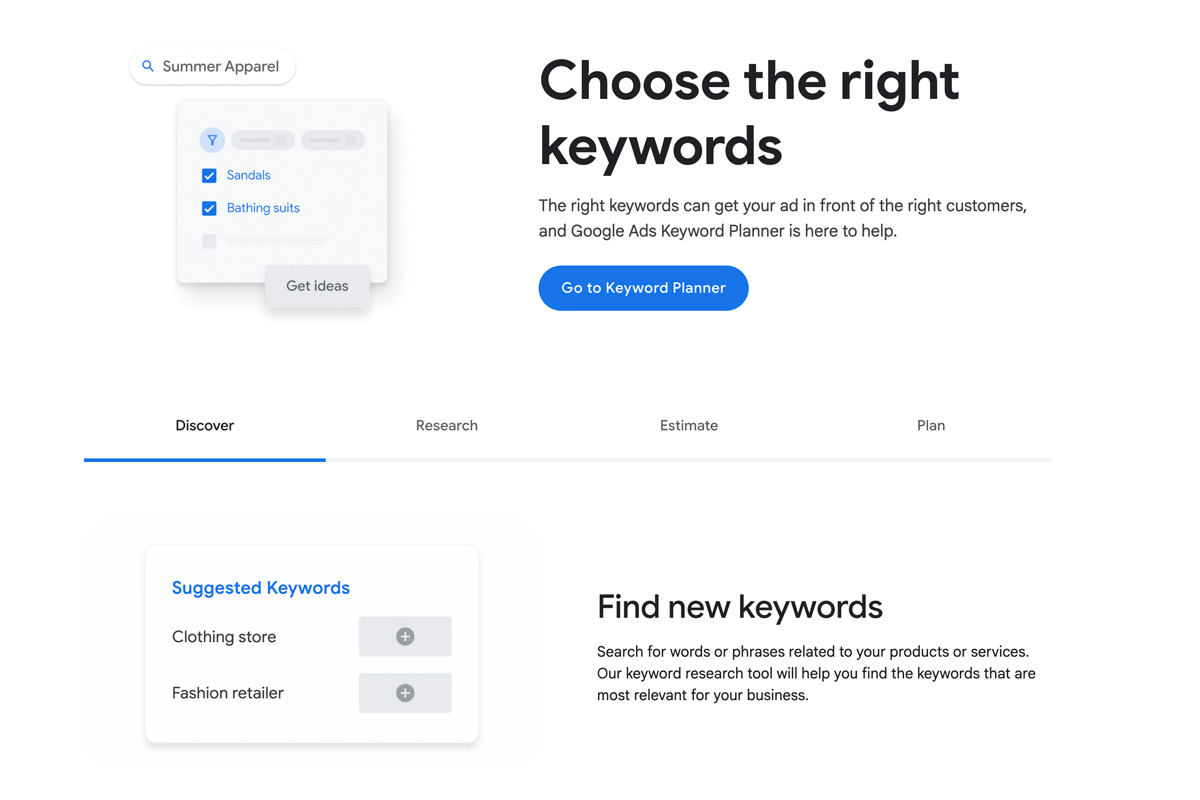
Tools and Tactics for Finding the Right Keywords
You don’t have to guess what parents are searching for. Several free and paid tools can help you uncover high-traffic, low-competition keywords tailored to your daycare’s location and services.
- Google Keyword Planner – Great for general terms and search volume estimates.
- Google Search Console – Shows what queries already bring people to your site.
- Ubersuggest – Helpful for discovering long-tail phrases and related topics.
- SEMrush and Ahrefs – Offer deep keyword analysis, competitor research, and SEO audits.
- AnswerThePublic – Visualizes common questions parents are asking in your niche.
You can also start by typing common phrases like “daycare in [your city]” into Google and looking at the autocomplete suggestions and “People Also Ask” sections. These clues show what’s top of mind for parents in your area.
When using keyword tools, look for a balance of relevance, volume, and competition. A keyword with 200 monthly searches in your city but low competition could be far more valuable than a national term with thousands of searches and no local intent.
Where and How to Use Keywords on Your Website
Once you’ve identified your primary and secondary keywords, the next step is making sure they appear in the right places on your site—naturally and strategically.
- Title tags – Every page should have a unique title tag that includes your core keyword and location. Example: “Montessori Daycare in Austin | Bright Steps Early Learning”
- Meta descriptions – Use your keyword and a call to action in the 150–160 character snippet that appears in search results.
- Headings (H1, H2, etc.) – Structure your content with clear, descriptive headings that include variations of your target terms.
- Body content – Mention your keyword early on, then sprinkle related terms throughout without forcing them. Keep the language parent-focused and easy to read.
- Image alt text – Describe images using keywords where appropriate, especially for facility photos or classroom images.
- URLs – Keep page URLs short and include your keyword when possible. Example: /infant-daycare-austin
- Internal links – Link between related pages using anchor text that reflects your keyword targets. For example, “Learn more about our toddler programs” should link to your toddler program page—not just say “click here.”
Avoid stuffing your content with keywords. Focus on clear, helpful language that mirrors how parents speak and search. Google is smart enough to recognize variations, so prioritize natural phrasing over repetition.
Long-term, strong keyword placement combined with useful, localized content will help search engines understand what your daycare offers—and help parents find you exactly when they need to.
On-Page SEO Best Practices for Daycare Websites
Optimizing each page on your website helps search engines understand your content and makes it easier for parents to find the information they need. On-page SEO includes everything from your titles and headings to the way your pages are structured and written.
Start with strong, descriptive title tags. These are the clickable headlines that show up in search results, so they should clearly communicate what each page is about. Include your target keyword and your location when relevant. For example: “Affordable Infant Daycare in Dallas | Little Sprouts Learning Center.”
Your meta descriptions are the short blurbs beneath the titles in search results. They don’t directly impact rankings, but they do influence clicks. A good meta description is clear, to the point, and speaks directly to what parents care about: safety, affordability, flexible hours, and educational value. Keep it under 160 characters and make sure every page has a unique one.
Use clear heading structures (H1, H2, H3) to organize your content. The H1 should be reserved for the page title, with H2s used to break the page into sections like “Toddler Programs” or “Our Philosophy.” H3s can be used for sub-sections under each H2. This not only helps readability but also gives search engines a better idea of how your content is organized.

Writing Content That Resonates with Parents
Your content should speak directly to the needs, concerns, and questions of local parents. Every page—whether it’s your homepage, service descriptions, or an “About Us” section—should help parents feel informed and confident in your program.
Here’s what parents are looking for when they visit your site:
- Clear descriptions of programs by age group (infants, toddlers, preschoolers)
- Curriculum highlights and your approach to learning
- Staff qualifications and background checks
- Safety procedures and cleanliness standards
- Operating hours and flexibility for working families
- Enrollment process and availability
You should also anticipate and answer common questions within the content. For example, instead of just saying “We offer full-day care,” include details like “Our full-day program runs from 7:30am to 6:00pm, Monday through Friday, with extended care available upon request.”
Adding a section for frequently asked questions (FAQs) is another great way to capture long-tail keyword traffic and address specific parent concerns.
Structuring for Featured Snippets and Search Questions
Featured snippets—those boxed answers at the top of Google’s results—are a shortcut to increased visibility. To increase your chances of appearing in these spots, format your content with clear, concise answers to specific questions.
For example:
Q: What is the child-to-teacher ratio at your daycare?
A: Our infant program maintains a 4:1 ratio, ensuring every baby receives close attention and care throughout the day.
Use bulleted lists, numbered steps, or short answer paragraphs. Google favors clean formatting and straightforward responses. This style also improves readability for parents skimming for quick answers.
If you add a dedicated FAQ page, structure each question as a subheading (H2 or H3), followed by a brief answer. You can also sprinkle mini-FAQ sections throughout service pages, which makes your content more dynamic and helps target a wider variety of search terms.
Internal Linking to Improve Navigation and SEO
Internal links help both users and search engines find their way around your site. Every page should point to related pages that expand on the topic or guide visitors to take the next step.
For example:
- Link from your homepage to individual program pages like “Infant Care” or “Preschool Curriculum”
- Within blog posts, link to relevant service pages. If you write about preparing for the first day of daycare, link to your enrollment page
- Use keyword-rich anchor text instead of generic phrases. Instead of saying “learn more,” use “learn more about our toddler daycare program”
Good internal linking creates a stronger site structure, keeps parents engaged longer, and signals to Google which pages are most important.
Effective on-page SEO is about more than just inserting keywords—it’s about creating a clear, parent-friendly experience that answers questions, builds trust, and guides visitors toward enrollment.
Technical SEO for a Smooth Parent Experience
A technically sound website not only helps search engines crawl and index your pages, it also ensures a smooth, stress-free experience for parents—especially those browsing on mobile or during quick breaks between errands or work. If your site loads slowly or breaks on a phone screen, you risk losing a potential enrollment before they even read your first sentence.
Start with page speed. Parents won’t wait more than a few seconds for a site to load. Compress your images, remove unnecessary plugins or scripts, and use modern, lightweight themes. Tools like Google PageSpeed Insights or GTmetrix can show you exactly what’s slowing your site down and how to fix it.
Mobile responsiveness is a must. Most daycare-related searches happen on smartphones, so your site should look clean and function well on any screen size. That means large buttons, readable text without zooming, and no pop-ups that cover the content. You can test your site with Google’s Mobile-Friendly Test to catch any layout issues that could drive parents away.
Prioritizing Security and Trust with HTTPS
Parents are naturally cautious about sharing personal information online—especially when it involves their children. A secure website signals professionalism and care. If your daycare’s website still runs on HTTP instead of HTTPS, it’s time to change that immediately.
An SSL certificate encrypts user data and enables HTTPS, which is now a minimum standard for all websites. Without it, modern browsers may flag your site as “Not Secure”—a red flag that could make parents bounce before even reading your homepage. Most hosting providers offer free SSL certificates or easy installation through your dashboard.
Keeping your website platform, themes, and plugins up to date also reduces the risk of hacks or vulnerabilities. Make sure your contact forms are protected with spam filters or captchas, and don’t collect sensitive data (like child health information) through unsecured channels.

Using Schema Markup to Enhance Search Results
Schema markup is behind-the-scenes code that helps search engines understand the content of your site. For daycare centers, it can improve how your listing appears in search results—sometimes even adding visual elements like review stars, event dates, or operating hours directly in Google’s display.
The most relevant schema types for child care businesses include:
- LocalBusiness: Highlights your name, address, phone number, and opening hours
- Review: Displays star ratings from parent testimonials if they’re marked up properly
- Event: Useful for open houses, tours, or enrollment deadlines
- Organization: Adds credibility and clarifies who you are
You don’t need to code this by hand. Tools like Google’s Structured Data Markup Helper or plugins like Rank Math and Yoast SEO can guide you through adding schema to your WordPress site. Once added, you can test your markup with Google’s Rich Results Test tool.
Indexing, Sitemaps, and Crawling Health
If search engines can’t access your pages, they can’t rank them. A clean, crawlable site structure ensures every important page on your website is indexed and eligible to appear in search results.
Create and submit an XML sitemap through Google Search Console to help Google discover all your pages. Most SEO plugins generate these automatically.
Use a robots.txt file to tell search engines which parts of your site to index or ignore. Be careful not to accidentally block key directories like your program pages or blog.
Regularly check for broken links and 404 errors. These not only frustrate visitors but also hurt your SEO. Tools like Screaming Frog or Search Console can help you identify and fix broken links quickly.
Maintaining your technical SEO ensures that all the great content you’ve created—your service pages, reviews, and blog posts—can actually be found, indexed, and ranked. It also helps create a polished, professional experience that reflects the care and attention you give to families every day.
Content Marketing That Builds Trust and Drives Enrollment
Creating helpful, engaging content is one of the most effective ways to attract local parents and build long-term visibility in search engines. A blog or resource section on your daycare website gives you the space to answer common parent questions, showcase your expertise, and rank for a wider range of keywords.
The key is to create content that aligns with real-life concerns. Think about the questions parents ask during tours or phone calls—those are the topics they’re Googling before they ever reach out.
Some blog post ideas that perform well:
- “How to Choose the Right Daycare for Your Child”
- “5 Signs Your Toddler Is Ready for Preschool”
- “What to Expect on Your Child’s First Day of Daycare”
- “The Benefits of Early Learning Programs”
- “How to Prepare Your Child Emotionally for Daycare”
Each of these topics targets long-tail search phrases while also positioning your daycare as a helpful, trusted resource.
Offering Downloadable Resources for Parents
Beyond blog posts, offering downloadable guides or checklists is a smart way to keep parents engaged. These resources can be shared on social media, included in emails, and linked throughout your site.
Some examples:
- “A Parent’s Guide to Enrolling in Daycare”
- “What to Pack for the First Day of Preschool”
- “Daily Routine Chart for Toddlers in Childcare”
- “Checklist: Questions to Ask During a Daycare Tour”
These types of resources provide value up front and can even be used to build an email list if you choose to add a simple opt-in form.

Sharing Stories and Testimonials That Connect
Real experiences go a long way in reassuring parents. When families read about others who’ve had a positive journey with your center, it makes your daycare more relatable and trustworthy.
Ways to feature testimonials:
- A dedicated testimonials page with quotes and parent names (with permission)
- A blog-style post sharing one family’s story—from their first tour to their child’s growth
- Video testimonials from parents talking about what they love most about your center
If you’ve helped a child overcome separation anxiety or transition smoothly from home care, those stories resonate deeply. Focus on specific moments and emotions, not just general praise.
Using Video to Let Parents See Inside
Video content builds familiarity. A quick tour of your classrooms, playground, and learning areas helps parents visualize their child in your environment—without scheduling a visit. This is especially valuable for busy families who are still narrowing down their options.
Ideas for daycare video content:
- A 1–2 minute virtual tour of your facility
- Teacher introductions with short bios or teaching philosophies
- Clips from daily activities, storytime, or art projects (with parent permission)
- A “day in the life” highlight reel
Host videos on YouTube (for SEO benefits) and embed them on your website. You can also share them on social media to increase reach.
FAQs That Answer Real Parent Concerns
An FAQ section isn’t just helpful—it’s an SEO asset. When written well, it can help you show up for voice search queries and featured snippets while giving parents the quick answers they’re looking for.
Common daycare-related FAQs to include:
- What age groups do you serve?
- What is your child-to-teacher ratio?
- What are your hours of operation?
- Do you provide meals and snacks?
- What safety protocols do you follow?
- Is there a waitlist? How do I enroll?
Keep answers clear, concise, and conversational. You can feature these on a dedicated FAQ page or include them at the bottom of key pages like your homepage or program pages.
Content marketing gives your daycare an ongoing way to connect with parents, improve your rankings, and build credibility—all while making your website more useful and trustworthy for families.
Building Backlinks to Increase Your Daycare’s Authority
Backlinks—links from other websites to yours—are one of the strongest signals Google uses to determine your site’s credibility. For daycare centers, earning high-quality backlinks from trusted, relevant sources can significantly improve your rankings in local search results.
But not all backlinks are created equal. A single link from a respected parenting blog, local news outlet, or educational organization carries more weight than dozens of low-quality links from unrelated directories.
Smart ways to earn backlinks include:
- Partnering with local pediatricians, libraries, or family-friendly businesses for resource sharing or events
- Getting listed on well-known childcare directories like Care.com, Winnie, or Niche
- Hosting or sponsoring community events, like storytime at the library or a neighborhood safety workshop
- Submitting press releases to local news sites for grand openings, new programs, or milestone anniversaries
Every backlink is a vote of confidence in your daycare—and an opportunity to expand your reach.
Collaborating with Local Organizations for Links and Referrals
One of the easiest ways to build backlinks (and real relationships) is through partnerships with other local organizations that also serve families.
Here are a few collaboration ideas:
- Offer to provide educational content or childcare tips for a local parenting group’s website or newsletter
- Co-host a workshop with an early education consultant, speech therapist, or child psychologist and promote it on both websites
- Connect with elementary schools and offer transition resources for families with younger siblings
- Ask local businesses if they have a resource page where your daycare could be listed as a trusted provider
These links often bring referral traffic along with SEO benefits, helping you reach parents who are actively researching or asking for recommendations.
Guest Blogging on Parenting and Childcare Sites
Contributing guest posts to parenting blogs or educational websites gives you exposure to new audiences and authoritative backlinks. Most reputable blogs allow a short author bio with a link back to your site—and if your content is valuable, they may even reference your center in the body of the article.
Effective guest post topics for daycare providers include:
- “How to Choose a Preschool That Fits Your Family”
- “The Importance of Play in Early Childhood Development”
- “5 Things Parents Should Look for During a Daycare Tour”
Focus on quality over quantity. A few solid guest posts on relevant, high-traffic sites can deliver better results than dozens of posts on low-value domains.
Using Social Media to Encourage Organic Linking
Social media doesn’t directly impact your search rankings, but it does help more people find and share your content. That increased visibility can lead to backlinks—especially when you’re regularly posting content that’s genuinely helpful or interesting to parents.
Here’s how to use social platforms for organic link growth:
- Share your blog posts and resource guides on Facebook, Instagram, and Pinterest
- Create short video clips or graphics that summarize your best tips and link back to the full post
- Encourage parents to share their experiences at your center (with permission), tagging your account and linking to your site
- Engage with local parenting forums and Facebook groups—not to self-promote, but to provide thoughtful advice that builds trust
Over time, these small touchpoints can lead to local bloggers, influencers, or organizations linking back to your site naturally.
Monitoring and Maintaining a Healthy Backlink Profile
As your daycare gains more backlinks, it’s important to monitor their quality and watch for any spammy or broken links that could harm your SEO.
Use tools like:
- Google Search Console – For basic backlink insights and performance
- Ahrefs or SEMrush – For more detailed analysis, link tracking, and competitor comparison
- Moz Link Explorer – For domain authority insights and link opportunities
If you find low-quality or suspicious links pointing to your site, you can disavow them through Google Search Console. This tells Google not to count them when evaluating your site’s authority.
Strong backlinks make your daycare site more authoritative, trustworthy, and visible. Combined with great content and solid technical SEO, they help move your site up the rankings and into the top spots where parents are most likely to click.
How Social Media Supports Your SEO Strategy
While social media doesn’t directly influence search rankings, it plays a key role in visibility, trust, and engagement—three things that matter deeply in the daycare space. A strong social media presence can help your content get discovered, increase traffic to your site, and encourage parents to share your posts, which may lead to organic backlinks over time.
Google also pays attention to branded searches. If more parents are searching your daycare by name because they saw you on Facebook or Instagram, that’s a signal of relevance and authority. Active social accounts show that your business is engaged, approachable, and real—which builds credibility with both search engines and local families.
Choosing the Right Social Platforms for Daycare Marketing
Not every platform makes sense for daycare centers. Focus your energy where local parents are most active and where visual content shines.
- Facebook: Great for community building, updates, events, reviews, and parent engagement. Use it for photo albums, daily updates, and links to your blog or website.
- Instagram: Ideal for visual storytelling. Share images of activities, classroom setups, and learning moments. Use Stories and Highlights to showcase different age groups or programs.
- YouTube: Perfect for hosting video tours, teacher intros, or short educational clips. These videos can be embedded on your website and shared via email.
- Pinterest: Great for driving traffic from parenting audiences. Share educational tips, crafts, checklists, and parenting resources that link back to your blog.
- Nextdoor: Valuable for connecting with nearby families. Participate in neighborhood conversations and respond when people ask for daycare recommendations.
You don’t need to be everywhere—just consistent and active on the platforms that matter to your audience.

Creating Content That Gets Shared and Noticed
Social content should reflect the personality of your center while providing value to current and prospective families. Aim to share a mix of community-focused, informative, and lighthearted content.
Examples include:
- Photos of children doing crafts, outdoor play, or celebrating milestones (with consent)
- Behind-the-scenes peeks into classroom routines or curriculum highlights
- Staff spotlights and teacher appreciation posts
- Quick tips for parents: healthy lunch ideas, sleep schedules, or potty training support
- Announcements about enrollment, open house events, or seasonal programs
- Quotes or kind words from parent testimonials
- Fun holidays or themed dress-up days
Use captions to tell a short story or highlight a benefit of your program. Always link back to your website or specific landing pages when promoting services or events.
Getting Involved in Parent Communities and Groups
Many parents rely on Facebook groups or local online communities to find recommendations and reviews. Participating in these spaces can build trust and attract families who may not have found you otherwise.
Here’s how to approach it:
- Join local parenting groups or neighborhood forums
- Offer helpful advice when parents ask about daycare-related concerns
- Share blog posts or resources without being overly promotional
- Comment with value before dropping a link—build relationships, not just clicks
This approach takes time but builds real credibility in the community. When people consistently see your name offering thoughtful support, they’re more likely to consider your center when the time comes to enroll.
Encouraging Parents to Share Their Experiences
One of the most authentic ways to build trust and visibility is through user-generated content. When parents post about their child’s experience at your daycare and tag your profile or location, it adds a layer of real-world validation that no ad or blog post can replicate.
Encourage this by:
- Asking parents to tag your daycare when posting about milestones or events
- Hosting fun giveaways where sharing a photo or tagging your account is part of entry
- Sharing their posts (with permission) on your own profile
- Featuring short testimonials from families in your Stories or feed
Even one parent’s post can reach dozens of other local families. Over time, these small signals create a ripple effect—amplifying your daycare’s presence both online and offline.
Combining PPC Advertising with SEO for Maximum Visibility
While SEO builds long-term visibility, pay-per-click (PPC) advertising offers instant exposure at the top of search results. Running Google Ads alongside your organic strategy can help your daycare appear in multiple spots on the page—greatly increasing your chances of getting noticed by parents who are ready to act.
If you're targeting competitive keywords like "daycare near me" or "preschool in [your city]," PPC allows you to bypass the wait time of ranking organically. You can generate leads right away, especially during peak enrollment periods or when launching a new program.
SEO and PPC are most effective when they work together. Use PPC to drive short-term inquiries while your SEO gains momentum and delivers results over the long haul.
Setting Up Google Ads Campaigns for Daycare Leads
To get started with Google Ads, you'll want to focus on high-intent searches—phrases parents use when they’re close to making a decision.
Effective keywords might include:
- “best daycare near me”
- “infant daycare in [city]”
- “Montessori preschool with availability”
- “full-time daycare with flexible hours”
Use geo-targeting to show your ads only within a certain radius of your location. This ensures your budget is focused on parents who can realistically enroll.
Other Google Ads tips:
- Use ad extensions to add extra info like your phone number, location, and reviews.
- Write clear, benefit-focused headlines, such as: “Enroll Today | Licensed Childcare with Flexible Hours.”
- Link to a relevant landing page, not just your homepage. If your ad promotes your toddler program, send visitors to that specific page.
- Enable call tracking to measure how many phone calls result directly from your ads.
Reaching Local Families with Location-Based Targeting
Location targeting is one of the biggest advantages of PPC for daycare businesses. With Google Ads, you can:
- Target specific zip codes, neighborhoods, or a custom radius
- Exclude areas outside your service range
- Adjust bids based on performance—investing more in areas that drive the most inquiries
You can even run different ad copy for different neighborhoods. For example, a higher-income suburb may respond better to messaging around early learning and enrichment, while a working-class neighborhood may prioritize flexible hours and affordability.
Budgeting and Measuring ROI for Paid Campaigns
PPC allows for tight control over your ad spend, but the key is making sure your investment turns into actual leads and enrollments. Start small—$10–$20 per day can go a long way in a local market—and increase your budget once you start seeing results.
Track key metrics like:
- Cost-per-click (CPC) – How much you’re paying for each visitor
- Click-through rate (CTR) – How often people click on your ad vs. how often it’s shown
- Conversion rate – How many visitors take action (call, fill out a form, schedule a tour)
- Cost per lead – Total spend divided by the number of new inquiries
Use Google Analytics and Google Ads conversion tracking to measure performance and improve over time. A/B test different ad copy, headlines, and landing pages to find what works best.
While SEO builds long-term traffic and trust, PPC fills in the gaps and accelerates your growth—especially when you need immediate leads or want to highlight specific programs. When used together, they create a complete, sustainable marketing strategy that drives real results.
Tracking SEO Performance for Your Daycare Website
Search engine optimization isn’t something you set once and forget—it’s an ongoing process that improves with data. Monitoring your SEO performance helps you understand what’s working, where parents are coming from, and where your site may be falling short. Regular tracking ensures that your efforts lead to real results: more inquiries, more tours, and more enrollments.
Start with Google Analytics, which shows how people are finding and using your site. Key data points to monitor include:
- Organic traffic: How many visitors come from unpaid search results
- Bounce rate: The percentage of people who leave after viewing one page
- Time on site: How long visitors are staying (a sign of engagement)
- Conversion goals: How many people submit forms, call, or schedule tours
Pair this with Google Search Console, which offers more search-specific insights:
- What keywords are driving traffic to your site
- Which pages are appearing in search results (and how often they’re clicked)
- Any technical errors, such as broken pages or indexing issues
Together, these tools provide a complete picture of how your daycare performs in organic search—and where to focus your next round of improvements.
Running Regular SEO Audits to Spot Issues
Just like you clean and organize your classrooms regularly, your website needs occasional checkups. An SEO audit is a structured review of your site’s performance and technical health. It helps identify problems that may be hurting your rankings or confusing visitors.
What to include in an SEO audit:
- Broken links: Fix 404 errors and remove outdated links
- Missing meta tags: Ensure every page has a unique title and meta description
- Duplicate content: Make sure no two pages have the same text or headings
- Slow loading pages: Use tools like PageSpeed Insights to speed things up
- Mobile usability: Check that your site works well on all devices
- Image optimization: Compress large files and use descriptive alt text
You can run audits manually or use tools like Screaming Frog, Ahrefs, or SEMrush to automate the process. Aim to review your site quarterly or any time you make major updates.
Using A/B Testing to Improve Conversions
Getting traffic is only half the equation—what matters is what parents do once they land on your site. A/B testing allows you to experiment with small changes and see what drives more inquiries.
Things you can test:
- Headlines: Try different wording on your homepage or program pages
- Calls to action (CTAs): Test buttons like “Schedule a Tour” vs. “Book a Visit”
- Form placement: Move contact forms higher on the page to encourage more submissions
- Page layouts: Compare a traditional layout vs. a video-focused version
Use tools like Google Optimize, Unbounce, or Hotjar to run and analyze these tests. Even small improvements—like changing a button color or shortening a form—can lead to more calls and completed forms.
Metrics That Matter Most to Daycare Owners
While SEO can feel technical, your ultimate goal is simple: enroll more families. Keep your focus on metrics that align with that outcome.
The most valuable KPIs include:
- Organic leads: How many inquiries come from unpaid search
- Phone call tracking: Are parents calling directly from your site or Google listing?
- Tour sign-ups: Are your SEO efforts driving actual appointments?
- Local Pack visibility: How often are you showing up in the 3-map listings for daycare-related searches?
By measuring what matters, you can tie your SEO strategy directly to business growth—and make smarter decisions about where to invest your time and budget.
Seasonal SEO Strategies to Align with Parent Search Cycles
Childcare demand isn’t consistent year-round. Parents tend to search for daycare options around specific life transitions—like starting a new job, moving to a new city, or preparing for the school year. By aligning your SEO content with these seasonal patterns, you can increase visibility at exactly the right times.
Key enrollment seasons include:
- Back-to-school (August–September): Parents look for preschool and toddler programs once older siblings return to school.
- New Year (January–February): Many families use the new year to make fresh plans, including switching or enrolling in daycare.
- Spring/Summer (April–June): Parents start searching for summer camps, flexible care, or transitional programs for toddlers preparing for preschool.
Use your blog and service pages to publish timely content that captures these trends. For example, in late summer, a post titled “How to Prepare Your Toddler for Preschool This Fall” can rank for both seasonal and evergreen keywords.
Creating Event-Based Content Around Tours and Open Houses
Events like open houses, parent info sessions, or virtual tours are perfect opportunities to generate local buzz—and search traffic. Create landing pages or blog posts optimized for search phrases like:
- “Daycare open house near me”
- “Preschool virtual tour in [city]”
- “Fall daycare enrollment event”
Include key details: what the event is, what parents can expect, who it’s for, and how to sign up. Promote it on your homepage, Google Business Profile, and social channels. After the event, update the page with photos or highlights to use as future proof of engagement.
You can also reuse and repurpose this content. A virtual tour video can be embedded on multiple pages, while a photo gallery from an open house can be shared seasonally to encourage sign-ups.
Leveraging Holiday Programs and School Breaks
Parents frequently search for childcare during holidays and school breaks. If your center offers coverage during these times, create specific landing pages and content around it.
Targeted keyword examples include:
- “Holiday daycare in [city]”
- “Winter break preschool programs”
- “Childcare during Thanksgiving week”
- “Summer camp for toddlers in [city]”
These seasonal keywords often have less competition but high urgency—parents need care quickly and are ready to make decisions. Make sure these pages are indexed, linked from your main navigation when active, and updated with relevant dates and availability each year.
Updating Listings and Profiles with Seasonal Offers
Your Google Business Profile, Yelp page, and Facebook business profile should reflect seasonal changes in availability, hours, and program offerings. Keeping these up to date improves trust and helps your center appear more frequently in local search results.
Update:
- Operating hours if you’re closed during holidays or open extended hours for special programs
- Descriptions and photos to highlight seasonal curriculum, themed activities, or upcoming events
- Posts and offers to promote limited-time enrollment or registration deadlines
Even a short update like “Now enrolling for our fall preschool program!” can improve click-through rates and engagement.
By planning your SEO content around seasonal demand, you can meet parents where they are—at the exact moment they’re looking for care. It’s one of the most efficient ways to boost visibility, fill open spots, and stay ahead of less proactive competitors.
Common SEO Mistakes That Hold Daycare Websites Back
Even with good intentions, many daycare websites make simple SEO mistakes that limit visibility and lead to missed opportunities. Avoiding these pitfalls is just as important as implementing best practices. By catching these issues early, you can improve your rankings and create a better experience for parents.
Neglecting Mobile Optimization
Most parents are searching for daycare on their phones, often while multitasking or on the go. If your site isn’t mobile-friendly, it can cause frustration and lead to higher bounce rates—meaning people leave your site without taking any action.
Avoid this by:
- Using a responsive design that adapts to all screen sizes
- Making sure text is easy to read without zooming
- Ensuring buttons are large enough to tap without difficulty
- Avoiding pop-ups that block important content
Run your site through Google’s Mobile-Friendly Test to catch and fix common issues.
Having No Blog or Content Strategy
Many daycare websites stop at basic info: home, about, programs, and contact. But without fresh content, you miss out on long-tail keywords, opportunities to rank for specific parent questions, and chances to build trust.
Make content part of your SEO plan by:
- Posting regular blogs that answer common parent concerns
- Updating existing service pages with new details or testimonials
- Including FAQs, resource guides, or enrollment tips
Even one well-written blog post a month can significantly expand your reach and bring in more qualified traffic.
Ignoring Local SEO Elements
A daycare business is inherently local, yet many websites don’t fully optimize for their city or neighborhood. This can lead to generic search results that don’t help families nearby find you.
Improve your local visibility by:
- Adding your city and neighborhood to page titles, descriptions, and headings
- Optimizing your Google Business Profile
- Listing your daycare in local directories and parenting resources
- Embedding a map on your contact page and including driving directions
Local SEO isn’t about broad visibility—it’s about reaching the right parents within a few miles of your center.
Failing to Track SEO Performance
If you’re not monitoring your traffic, keyword rankings, or user behavior, you’re flying blind. Without data, it’s hard to know what’s working or where to improve.
Avoid this mistake by:
- Installing Google Analytics and Google Search Console
- Setting up conversion goals (e.g., form submissions, calls)
- Reviewing reports monthly to look for growth or drops in traffic
- Making adjustments based on performance trends
SEO is not a one-time setup—it’s a system that requires feedback and refinement over time.
Overlooking the Power of Online Reviews
Many daycare owners underestimate the SEO and trust-building power of parent reviews. A lack of reviews—or poor review management—can cost you in both rankings and enrollment.
To stay ahead:
- Regularly ask happy parents to leave reviews on Google, Yelp, and Facebook
- Respond to every review, thanking families and addressing concerns politely
- Highlight testimonials on your website and in your marketing materials
Your reviews don’t just help with SEO—they help future parents feel confident in choosing your center.
By avoiding these common mistakes and staying proactive, your daycare can climb higher in search results, connect with more families, and turn your website into a reliable source of leads and enrollments.
Choosing Between DIY SEO and Hiring an Agency
If you're a daycare owner trying to improve your website’s visibility, one of the biggest questions you'll face is whether to handle SEO in-house or hire an outside expert. Both paths can work—but which one makes sense depends on your time, budget, and comfort level with the technical side of marketing.
Managing SEO yourself can save money, but it takes consistent effort. Hiring an agency gives you access to professional expertise, but comes with a higher price tag. The key is to understand what you're getting into before choosing one approach over the other.
When It Makes Sense to Hire an SEO Agency
If your daycare is in a competitive market—or if you simply don’t have time to manage your website—an SEO agency can help you move faster and avoid costly mistakes. Agencies often bring specialized tools, technical knowledge, and a repeatable strategy that would take months to learn on your own.
Consider hiring an expert if:
- You’ve already tried to improve your rankings without success
- You don’t have time to write content, manage listings, or analyze performance
- You need technical fixes—like improving site speed or setting up schema markup
- You're opening a new location and want to generate leads quickly
A good agency will offer more than just keywords—they’ll help with local listings, content creation, backlink strategy, and performance tracking.
What to Look For in an SEO Provider
Not all SEO agencies understand how to market child care services. Look for a provider with a clear process and experience working with local or family-focused businesses.
Ask these questions:
- Do they have case studies or examples from other daycare or service-based businesses?
- Do they specialize in local SEO?
- Will they provide monthly reports and explain what they’re doing?
- Do they write custom content, or rely on generic blog posts?
- Are they transparent about their pricing, timelines, and tools?
Avoid agencies that promise “#1 rankings in 30 days” or use outdated tactics like keyword stuffing or link farms. Those methods can damage your site’s reputation in the long run.
Understanding the Cost of SEO Services
SEO pricing varies widely depending on the level of service and the competition in your area. Here's a rough guide to typical ranges:
- Local SEO packages: $500–$2,000/month (Google Business Profile optimization, reviews, citations)
- Full-service SEO: $2,000–$5,000/month (includes content, technical SEO, backlinks, strategy)
- One-time SEO audits: $1,000–$3,000 (for a deep dive and roadmap without ongoing work)
If you go this route, think of SEO as a long-term investment. It may take a few months to see major movement, but once you're ranking well, the traffic and leads continue without the ongoing cost of ads.
Pros and Cons: DIY SEO vs. Hiring an Agency
| Factor | DIY SEO | Hiring an SEO Agency |
|---|---|---|
| Cost | Lower upfront cost | Higher investment |
| Control | Full control of content and direction | Less hands-on |
| Time | Time-intensive, ongoing | Time-saving |
| Expertise | Requires learning and testing | Access to professionals |
| Results | Can be effective with effort | Often faster and more consistent |
If you enjoy writing, have some technical comfort, and are willing to learn, you can absolutely handle SEO yourself—especially in less competitive areas. But if your time is limited or you want faster results, partnering with a skilled agency may be the smarter choice.
There’s no one-size-fits-all answer. What matters is that your SEO gets done consistently and thoughtfully—whether by you, a team member, or a trusted partner.

Bringing It All Together: Making SEO Work for Your Daycare
Everything from your Google Business Profile to your blog content, backlinks, and mobile site performance contributes to how easily parents can find your daycare online. SEO isn’t a single tactic—it’s a system that works best when every piece is aligned around your local market and the needs of families searching for care.
Whether you’re just getting started or refining what’s already in place, your goal should be to increase visibility, build trust, and make it easy for parents to take the next step—whether that’s scheduling a tour, calling with a question, or filling out an enrollment form.
Actionable SEO Steps You Can Take Today
If you’re not sure where to start, here are high-impact steps you can begin implementing right away:
- Claim and fully complete your Google Business Profile: Add photos, hours, services, and enable messaging.
- Check your NAP consistency: Make sure your name, address, and phone number are the same across your website, directories, and social profiles.
- Conduct basic keyword research: Use Google Keyword Planner or Ubersuggest to find search terms local parents are using—and add them to your site naturally.
- Write or update your service pages: Include details parents care about, like hours, age groups, daily routines, and staff qualifications.
- Add a blog or resource section: Publish helpful articles that answer common questions or support families during transitions.
- List your daycare on local directories: Start with Yelp, Care.com, BBB, Facebook, and your city’s chamber of commerce site.
- Encourage parent reviews: Reach out to families who’ve had a great experience and guide them to your Google profile to leave a review.
- Improve your site speed and mobile usability: Compress images, remove unnecessary plugins, and use a responsive design.
- Track your performance: Set up Google Analytics and Search Console to see where traffic is coming from and how your site is performing.
You don’t need to do everything all at once. SEO success is built through consistent, intentional effort over time. Small steps—taken regularly—lead to major gains in visibility and trust.
Why Ongoing SEO Is Essential
Search algorithms evolve. Competitors update their websites. New parents enter the market every week. That’s why SEO isn’t a one-time fix—it’s an ongoing investment in your daycare’s growth.
By continuing to create content, update your site, earn backlinks, and engage with local families, you keep your digital presence strong and competitive. The best part? Unlike paid ads, the visibility you earn through SEO compounds over time. One great blog post can bring in traffic for years. One review can influence dozens of future decisions.
The families you’re trying to reach are already searching. A strong SEO strategy makes sure you’re right there when they need you—clear, helpful, and easy to choose.


